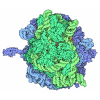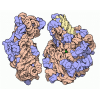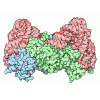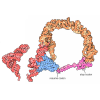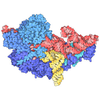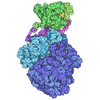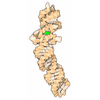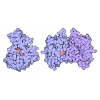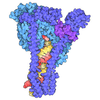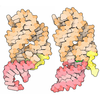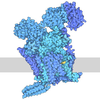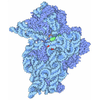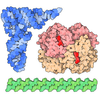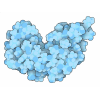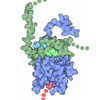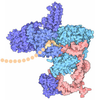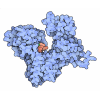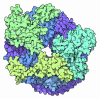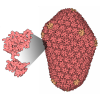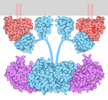[English] 日本語
 Yorodumi
Yorodumi- PDB-6xa1: Structure of a drug-like compound stalled human translation termi... -
+ Open data
Open data
- Basic information
Basic information
| Entry | Database: PDB / ID: 6xa1 | |||||||||
|---|---|---|---|---|---|---|---|---|---|---|
| Title | Structure of a drug-like compound stalled human translation termination complex | |||||||||
 Components Components |
| |||||||||
 Keywords Keywords | RIBOSOME / Selectively stalling / translation termination / drug-like compound / human ribosome | |||||||||
| Function / homology |  Function and homology information Function and homology informationtranslation termination factor activity / translation release factor complex / cytoplasmic translational termination / regulation of translational termination / translation release factor activity, codon specific / protein methylation / exit from mitosis / eukaryotic 80S initiation complex / negative regulation of protein neddylation / response to insecticide ...translation termination factor activity / translation release factor complex / cytoplasmic translational termination / regulation of translational termination / translation release factor activity, codon specific / protein methylation / exit from mitosis / eukaryotic 80S initiation complex / negative regulation of protein neddylation / response to insecticide / translation release factor activity / optic nerve development / regulation of translation involved in cellular response to UV / negative regulation of endoplasmic reticulum unfolded protein response / oxidized pyrimidine DNA binding / response to TNF agonist / positive regulation of base-excision repair / axial mesoderm development / negative regulation of formation of translation preinitiation complex / positive regulation of respiratory burst involved in inflammatory response / regulation of G1 to G0 transition / ribosomal protein import into nucleus / positive regulation of intrinsic apoptotic signaling pathway in response to DNA damage / positive regulation of gastrulation / protein tyrosine kinase inhibitor activity / protein-DNA complex disassembly / positive regulation of endodeoxyribonuclease activity / IRE1-RACK1-PP2A complex / nucleolus organization / sequence-specific mRNA binding / positive regulation of Golgi to plasma membrane protein transport / positive regulation of intrinsic apoptotic signaling pathway in response to DNA damage by p53 class mediator / 90S preribosome assembly / retinal ganglion cell axon guidance / TNFR1-mediated ceramide production / negative regulation of DNA repair / negative regulation of RNA splicing / GAIT complex / peptidyl-tRNA hydrolase activity / positive regulation of DNA damage response, signal transduction by p53 class mediator / supercoiled DNA binding / TORC2 complex binding / neural crest cell differentiation / G1 to G0 transition / NF-kappaB complex / nuclear-transcribed mRNA catabolic process, nonsense-mediated decay / cysteine-type endopeptidase activator activity involved in apoptotic process / oxidized purine DNA binding / positive regulation of ubiquitin-protein transferase activity / negative regulation of intrinsic apoptotic signaling pathway in response to hydrogen peroxide / regulation of establishment of cell polarity / negative regulation of bicellular tight junction assembly / ubiquitin-like protein conjugating enzyme binding / middle ear morphogenesis / negative regulation of phagocytosis / rRNA modification in the nucleus and cytosol / Formation of the ternary complex, and subsequently, the 43S complex / erythrocyte homeostasis / cytoplasmic side of rough endoplasmic reticulum membrane / laminin receptor activity / negative regulation of ubiquitin protein ligase activity / protein kinase A binding / ion channel inhibitor activity / Ribosomal scanning and start codon recognition / homeostatic process / Translation initiation complex formation / pigmentation / positive regulation of mitochondrial depolarization / macrophage chemotaxis / positive regulation of T cell receptor signaling pathway / negative regulation of Wnt signaling pathway / fibroblast growth factor binding / lung morphogenesis / monocyte chemotaxis / male meiosis I / positive regulation of natural killer cell proliferation / positive regulation of activated T cell proliferation / negative regulation of translational frameshifting / TOR signaling / Protein hydroxylation / BH3 domain binding / SARS-CoV-1 modulates host translation machinery / regulation of adenylate cyclase-activating G protein-coupled receptor signaling pathway / iron-sulfur cluster binding / regulation of cell division / cellular response to ethanol / mTORC1-mediated signalling / Peptide chain elongation / Selenocysteine synthesis / Formation of a pool of free 40S subunits / positive regulation of intrinsic apoptotic signaling pathway by p53 class mediator / endonucleolytic cleavage to generate mature 3'-end of SSU-rRNA from (SSU-rRNA, 5.8S rRNA, LSU-rRNA) / Eukaryotic Translation Termination / ubiquitin ligase inhibitor activity / positive regulation of GTPase activity / cellular response to actinomycin D / Response of EIF2AK4 (GCN2) to amino acid deficiency / blastocyst development / SRP-dependent cotranslational protein targeting to membrane / negative regulation of ubiquitin-dependent protein catabolic process Similarity search - Function | |||||||||
| Biological species |  Homo sapiens (human) Homo sapiens (human) | |||||||||
| Method | ELECTRON MICROSCOPY / single particle reconstruction / cryo EM / Resolution: 2.8 Å | |||||||||
 Authors Authors | Li, W. / Cate, J. | |||||||||
| Funding support |  United States, 2items United States, 2items
| |||||||||
 Citation Citation |  Journal: Nat Commun / Year: 2020 Journal: Nat Commun / Year: 2020Title: Selective inhibition of human translation termination by a drug-like compound. Authors: Wenfei Li / Stacey Tsai-Lan Chang / Fred R Ward / Jamie H D Cate /  Abstract: Methods to directly inhibit gene expression using small molecules hold promise for the development of new therapeutics targeting proteins that have evaded previous attempts at drug discovery. Among ...Methods to directly inhibit gene expression using small molecules hold promise for the development of new therapeutics targeting proteins that have evaded previous attempts at drug discovery. Among these, small molecules including the drug-like compound PF-06446846 (PF846) selectively inhibit the synthesis of specific proteins, by stalling translation elongation. These molecules also inhibit translation termination by an unknown mechanism. Using cryo-electron microscopy (cryo-EM) and biochemical approaches, we show that PF846 inhibits translation termination by arresting the nascent chain (NC) in the ribosome exit tunnel. The arrested NC adopts a compact α-helical conformation that induces 28 S rRNA nucleotide rearrangements that suppress the peptidyl transferase center (PTC) catalytic activity stimulated by eukaryotic release factor 1 (eRF1). These data support a mechanism of action for a small molecule targeting translation that suppresses peptidyl-tRNA hydrolysis promoted by eRF1, revealing principles of eukaryotic translation termination and laying the foundation for new therapeutic strategies. | |||||||||
| History |
|
- Structure visualization
Structure visualization
| Movie |
 Movie viewer Movie viewer |
|---|---|
| Structure viewer | Molecule:  Molmil Molmil Jmol/JSmol Jmol/JSmol |
- Downloads & links
Downloads & links
- Download
Download
| PDBx/mmCIF format |  6xa1.cif.gz 6xa1.cif.gz | 4.6 MB | Display |  PDBx/mmCIF format PDBx/mmCIF format |
|---|---|---|---|---|
| PDB format |  pdb6xa1.ent.gz pdb6xa1.ent.gz | Display |  PDB format PDB format | |
| PDBx/mmJSON format |  6xa1.json.gz 6xa1.json.gz | Tree view |  PDBx/mmJSON format PDBx/mmJSON format | |
| Others |  Other downloads Other downloads |
-Validation report
| Summary document |  6xa1_validation.pdf.gz 6xa1_validation.pdf.gz | 2.2 MB | Display |  wwPDB validaton report wwPDB validaton report |
|---|---|---|---|---|
| Full document |  6xa1_full_validation.pdf.gz 6xa1_full_validation.pdf.gz | 2.6 MB | Display | |
| Data in XML |  6xa1_validation.xml.gz 6xa1_validation.xml.gz | 387.5 KB | Display | |
| Data in CIF |  6xa1_validation.cif.gz 6xa1_validation.cif.gz | 648.8 KB | Display | |
| Arichive directory |  https://data.pdbj.org/pub/pdb/validation_reports/xa/6xa1 https://data.pdbj.org/pub/pdb/validation_reports/xa/6xa1 ftp://data.pdbj.org/pub/pdb/validation_reports/xa/6xa1 ftp://data.pdbj.org/pub/pdb/validation_reports/xa/6xa1 | HTTPS FTP |
-Related structure data
| Related structure data |  22085MC M: map data used to model this data C: citing same article ( |
|---|---|
| Similar structure data |
- Links
Links
- Assembly
Assembly
| Deposited unit | 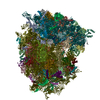
|
|---|---|
| 1 |
|
- Components
Components
+60S ribosomal protein ... , 41 types, 41 molecules LALBLCLDLELFLGLHLILJLLLMLNLOLPLQLRLSLTLVLWLXLYLZLaLbLcLdLeLf...
-RNA chain , 6 types, 6 molecules L5L7L8S2Bvk
| #3: RNA chain | Mass: 1138224.750 Da / Num. of mol.: 1 Source method: isolated from a genetically manipulated source Details: 28SrRNA with PF846 / Source: (gene. exp.)  Homo sapiens (human) / Production host: Homo sapiens (human) / Production host:  Homo sapiens (human) Homo sapiens (human) |
|---|---|
| #4: RNA chain | Mass: 38691.914 Da / Num. of mol.: 1 Source method: isolated from a genetically manipulated source Source: (gene. exp.)  Homo sapiens (human) / Production host: Homo sapiens (human) / Production host:  Homo sapiens (human) / References: GenBank: 23898 Homo sapiens (human) / References: GenBank: 23898 |
| #5: RNA chain | Mass: 49852.496 Da / Num. of mol.: 1 Source method: isolated from a genetically manipulated source Source: (gene. exp.)  Homo sapiens (human) / Production host: Homo sapiens (human) / Production host:  Homo sapiens (human) Homo sapiens (human) |
| #46: RNA chain | Mass: 514092.625 Da / Num. of mol.: 1 Source method: isolated from a genetically manipulated source Source: (gene. exp.)  Homo sapiens (human) / Production host: Homo sapiens (human) / Production host:  Homo sapiens (human) Homo sapiens (human) |
| #80: RNA chain | Mass: 24641.777 Da / Num. of mol.: 1 Source method: isolated from a genetically manipulated source Source: (gene. exp.)  Homo sapiens (human) / Production host: Homo sapiens (human) / Production host:  Homo sapiens (human) Homo sapiens (human) |
| #82: RNA chain | Mass: 4047.445 Da / Num. of mol.: 1 Source method: isolated from a genetically manipulated source Source: (gene. exp.)  Homo sapiens (human) / Production host: Homo sapiens (human) / Production host:  Homo sapiens (human) Homo sapiens (human) |
-Protein , 3 types, 3 molecules LUSgj
| #23: Protein | Mass: 11722.535 Da / Num. of mol.: 1 Source method: isolated from a genetically manipulated source Source: (gene. exp.)  Homo sapiens (human) / Production host: Homo sapiens (human) / Production host:  Homo sapiens (human) / References: UniProt: Q7Z4W8 Homo sapiens (human) / References: UniProt: Q7Z4W8 |
|---|---|
| #67: Protein | Mass: 34669.113 Da / Num. of mol.: 1 Source method: isolated from a genetically manipulated source Source: (gene. exp.)  Homo sapiens (human) / Gene: RACK1, GNB2L1, HLC7, PIG21 / Production host: Homo sapiens (human) / Gene: RACK1, GNB2L1, HLC7, PIG21 / Production host:  Homo sapiens (human) / References: UniProt: P63244 Homo sapiens (human) / References: UniProt: P63244 |
| #81: Protein | Mass: 46149.758 Da / Num. of mol.: 1 Source method: isolated from a genetically manipulated source Source: (gene. exp.)  Homo sapiens (human) / Gene: ETF1, ERF1, RF1, SUP45L1 / Production host: Homo sapiens (human) / Gene: ETF1, ERF1, RF1, SUP45L1 / Production host:  Homo sapiens (human) / References: UniProt: P62495 Homo sapiens (human) / References: UniProt: P62495 |
+40S ribosomal protein ... , 32 types, 32 molecules SASBSDSESFSHSISKSLSPSQSRSSSTSUSVSXSaScSdSCSGSJSMSNSOSWSYSZSbSeSf
-Protein/peptide , 1 types, 1 molecules NC
| #83: Protein/peptide | Mass: 2523.151 Da / Num. of mol.: 1 Source method: isolated from a genetically manipulated source Source: (gene. exp.)  Homo sapiens (human) / Production host: Homo sapiens (human) / Production host:  Homo sapiens (human) Homo sapiens (human) |
|---|
-Non-polymers , 4 types, 201 molecules 






| #84: Chemical | ChemComp-MG / #85: Chemical | ChemComp-MVM / | #86: Chemical | ChemComp-ZN / #87: Chemical | |
|---|
-Details
| Has ligand of interest | Y |
|---|---|
| Has protein modification | Y |
-Experimental details
-Experiment
| Experiment | Method: ELECTRON MICROSCOPY |
|---|---|
| EM experiment | Aggregation state: PARTICLE / 3D reconstruction method: single particle reconstruction |
- Sample preparation
Sample preparation
| Component | Name: Drug-like compound-stalled translation termination complex Type: RIBOSOME / Entity ID: #1-#83 / Source: RECOMBINANT |
|---|---|
| Source (natural) | Organism:  Homo sapiens (human) Homo sapiens (human) |
| Source (recombinant) | Organism:  Homo sapiens (human) Homo sapiens (human) |
| Buffer solution | pH: 7.6 |
| Specimen | Embedding applied: NO / Shadowing applied: NO / Staining applied: NO / Vitrification applied: YES |
| Specimen support | Details: unspecified |
| Vitrification | Cryogen name: ETHANE |
- Electron microscopy imaging
Electron microscopy imaging
| Experimental equipment |  Model: Titan Krios / Image courtesy: FEI Company |
|---|---|
| Microscopy | Model: FEI TITAN KRIOS |
| Electron gun | Electron source:  FIELD EMISSION GUN / Accelerating voltage: 300 kV / Illumination mode: FLOOD BEAM FIELD EMISSION GUN / Accelerating voltage: 300 kV / Illumination mode: FLOOD BEAM |
| Electron lens | Mode: BRIGHT FIELD |
| Image recording | Electron dose: 50 e/Å2 / Film or detector model: GATAN K2 SUMMIT (4k x 4k) |
- Processing
Processing
| CTF correction | Type: NONE |
|---|---|
| 3D reconstruction | Resolution: 2.8 Å / Resolution method: FSC 0.143 CUT-OFF / Num. of particles: 57324 / Symmetry type: POINT |
 Movie
Movie Controller
Controller



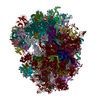
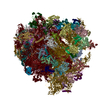
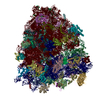


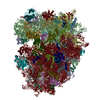
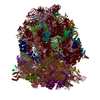
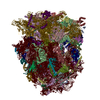


 PDBj
PDBj